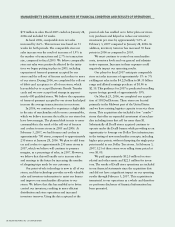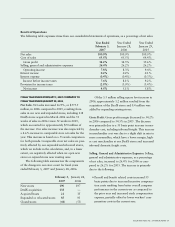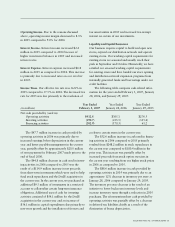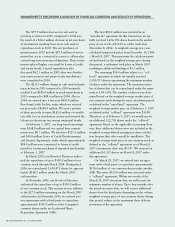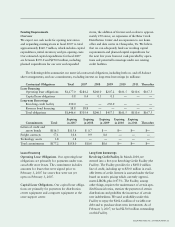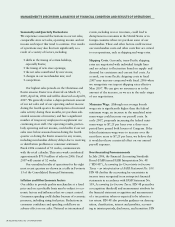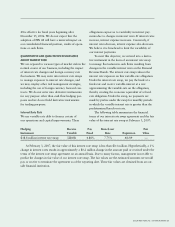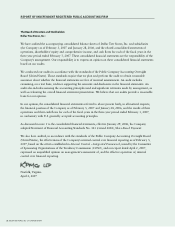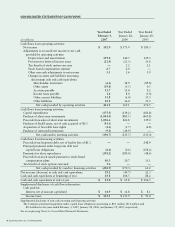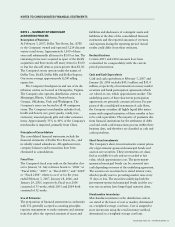Dollar Tree 2006 Annual Report Download - page 24
Download and view the complete annual report
Please find page 24 of the 2006 Dollar Tree annual report below. You can navigate through the pages in the report by either clicking on the pages listed below, or by using the keyword search tool below to find specific information within the annual report.
Revenue Bond Financing. In May 1998, we entered
into an agreement with the Mississippi Business
Finance Corporation under which it issued $19.0 mil-
lion of variable-rate demand revenue bonds. We used
the proceeds from the bonds to finance the acquisi-
tion, construction and installation of land, buildings,
machinery and equipment for our distribution facility
in Olive Branch, Mississippi. At February 3, 2007, the
balance outstanding on the bonds was $18.8 million.
These bonds are due to be fully repaid in June 2018.
The bonds do not have a prepayment penalty as long
as the interest rate remains variable. The bonds con-
tain a demand provision and, therefore, outstanding
amounts are classified as current liabilities. We pay
interest monthly based on a variable-interest rate,
which was 5.4% at February 3, 2007.
Commitments
Letters of Credit and Surety Bonds. In March 2001,
we entered into a Letter of Credit Reimbursement and
Security Agreement, which provides $125.0 million
for letters of credit. In December 2004, we entered
into an additional Letter of Credit Reimbursement
and Security Agreement, which provides $50.0 mil-
lion for letters of credit. Letters of credit are generally
issued for the routine purchase of imported merchan-
dise and we had approximately $84.8 million of
purchases committed under these letters of credit at
February 3, 2007. We also have approximately $31.5
million of letters of credit or surety bonds outstanding
for our insurance programs and certain utility pay-
ment obligations at some of our stores.
Freight Contracts. We have contracted outbound
freight services from various carriers with contracts
expiring through April 2009. The total amount of
these commitments is approximately $57.1 million.
Technology Assets. We have commitments totaling
approximately $3.8 million to primarily purchase
store technology assets for our stores during 2007.
Derivative Financial Instruments
We are party to one interest rate swap, which allows
us to manage the risk associated with interest rate
MANAGEMENT’S DISCUSSION & ANALYSIS OF FINANCIAL CONDITION AND RESULTS OF OPERATIONS
fluctuations on the demand revenue bonds. The swap
is based on a notional amount of $18.8 million.
Under the $18.8 million agreement, as amended, we
pay interest to the bank that provided the swap at a
fixed rate. In exchange, the financial institution pays
us at a variable-interest rate, which is similar to the
rate on the demand revenue bonds. The variable-
interest rate on the interest rate swap is set monthly.
No payments are made by either party under the
swap for monthly periods with an established interest
rate greater than a predetermined rate (the knock-out
rate). The swap may be canceled by the bank or us
and settled for the fair value of the swap as deter-
mined by market rates and expires in 2009.
Because of the knock-out provision in the $18.8
million swap, changes in the fair value of that swap
are recorded in earnings. For more information on the
interest rate swaps, see “Quantitative and Qualitative
Disclosures About Market Risk – Interest Rate Risk.”
Critical Accounting Policies
The preparation of financial statements requires the
use of estimates. Certain of our estimates require a
high level of judgment and have the potential to have
a material effect on the financial statements if actual
results vary significantly from those estimates.
Following is a discussion of the estimates that we
consider critical.
Inventory Valuation
As discussed in Note 1 to the Consolidated
Financial Statements, inventories at the distribution
centers are stated at the lower of cost or market
with cost determined on a weighted-average basis.
Cost is assigned to store inventories using the retail
inventory method on a weighted-average basis.
Under the retail inventory method, the valuation of
inventories at cost and the resulting gross margins
are computed by applying a calculated cost-to-retail
ratio to the retail value of inventories. The retail
inventory method is an averaging method that has
been widely used in the retail industry and results in
valuing inventories at lower of cost or market when
markdowns are taken as a reduction of the retail
value of inventories on a timely basis.
22 DOLLAR TREE STORES, INC. • 2006 ANNUAL REPORT






